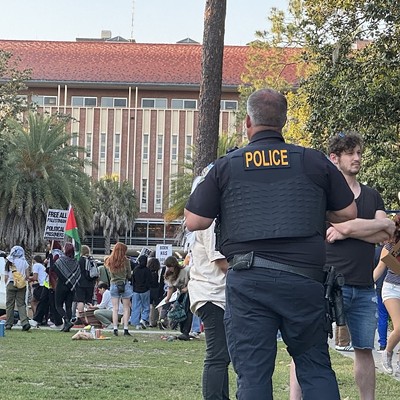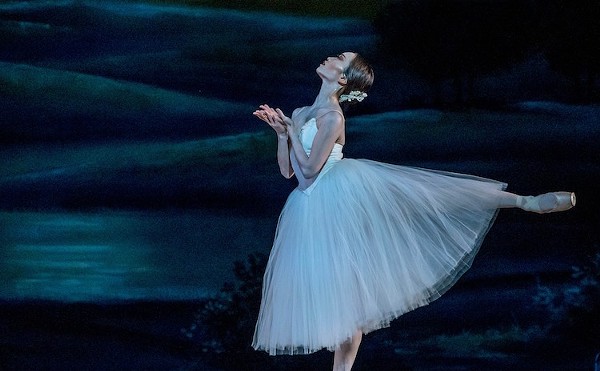Lauren Austin has lived many lives. While she is currently the community artist—in-residence at the Atlantic Center for the Arts in New Smyrna Beach, she only recently dedicated her life to being a full-time textile artist. She majored in Latin American studies at Dartmouth College, even though a teacher had told her that she didn't have a "facility for languages." After she graduated, she worked at the state department in Mexico and Uruguay for eight years as a consular officer, visiting U.S. citizens in jail and issuing replacement passports. After she came back from Latin America, she attended Syracuse University College of Law under a three-year fellowship and had the first of her two sons. She was the director of the Tompkins County Human Rights Commission and a law professor at Syracuse, her alma mater.
"I made my first quilt when I was 8, and I never stopped quilting except during those three years at law school. It was just impossible. That was a terrible time." Austin specializes in quilts made from her own hand-dyed and hand-painted materials, though occasionally she uses traditional African cloth, such as a kente from Ghana. The colors of Austin's quilts are luscious and warm, but it's more often the story behind the quilts that makes them resonate.
Many of her quilts are both political and personal, drawing together a coming to terms with events in her own life and in the lives of others. "Lucy Goes to Vote" commemorates the journey of the South African women who walked miles from their small villages to vote in the free election of Nelson Mandela. The background is painted, using a soda-ash method that takes the dye and thickens it to the consistency of paint and then stains the material. Neon pinks and yellows twist into an enormous flaming sun, which is intricately sewn with red and yellow metallic thread. In the forefront stands an African woman with a baby on her back, walking barefoot in the sand to the polls. The baby was made to look like her oldest son, Jessie, who himself was taking his first steps toward leaving home at the time.
"News reports of hundreds of thousands walking … to cast their votes made me wonder what women were thinking and feeling as they walked with their families and neighbors. My grandmother told me stories of lines of black people waiting to vote after universal suffrage in 1964," Austin says.
The griot from West Africa is a recurring inspiration that weaves its way through her work. That's the person who carries on the stories and heroes of the African culture to the next generation. Her grandmother told Austin stories about their own family's heroics during Jim Crow and the civil rights movement while she braided her hair as a girl. Now Austin brings her stories to a new audience through her graphic quilts.
"Did You Hear Her Son's in Trouble?" consists of three quilts, each representing a character within a greater story. One quilt is a mother wearing silver bracelets, waiting for her son to be sentenced in court. The second is a ghost-white judge rendering a verdict. Finally, there's an expressionless black man in shackles with his eyes closed. The same silver material is used on the son's shackles and the mother's bracelets. Austin had thought she'd be exempt from jury duty because she was a lawyer, but she was once called up to sit in on the domestic abuse case of a young black man and the experience inspired her creation.
In her artist's statement she says, "Wherever this quilt has been shown, people have approached me and shared often tragic stories of a family member or friend on trial or in jail. I tried to capture the attitude of the judge during, for him, a routine day and one of hundreds of similar cases he had tried, the stone face of the defendant in front of a room full of white faces and the worry of the mother as she watches the fate and future of her son decided by strangers." Austin uses the medium of quilting to tackle issues that are difficult for her to resolve in her mind; she says it helps her to flush out the significance and inner resolution.
As a resident at ACA, Austin organizes community outreach programs at local schools. Recently, she was awarded a grant from Darden Restaurants Inc. that has enabled her to teach fundamental drawing every Thursday at Oak Ridge High School in Orlando. The grant also provides watercolor pencils and sketch pads for the students.
"They don't have the same filters that adults have," Austin says, finding the opportunity to show works in progress to teenagers humbling and indispensable. "They thought my latest quilt was a merman, so I had to rethink the layout."
Her most recent work involves Aladdin's genie; titled "Why Is Aladdin a Hero?" it deals with the legacy of slavery. "These amazing people got sucked into a bottle and made to create a nation," Austin says. "Many times we don't really say what we think about issues of race or difference or womanhood. We can't really grow if we don't talk about it."
Once seen as haphazard or disorganized, African-American story quilts are now viewed as a legitimate form of textile art. Still, Austin continues to battle the traditional archetype of quilts and what denotes their quality. Among her inspirations, she lists Harriet Powers, one of the first known Southern African-American story quilters. "She had these two quilts, and they were her opus. They were her finest. Then after the Civil War, her family came on tough times and she was forced to sell them to a Jennie Smith, a woman who'd offered to buy them at a fair. She went in to the Smiths' house with the quilts and asked for $10, but the woman only offered her five. Harriet went outside and talked with her husband and then she went back and took the $5 for her quilts. The woman offered Harriet a bag full of material scraps when she left, but she refused them. She accepted the $5, but she always went back to the house to look at those quilts. That's how important they were to her." To this day, Harriet Powers' quilts are regarded as some of the finest examples of quilting anywhere. The stitches are so uniform and small, some find it hard to believe they were sewn by hand, but they make no use of conventional patterns or shapes. Austin speaks emphatically about the different between medium and meaning.
"That's why I'm concentrating on museums instead of competitions. There is a good art quilt movement right now, but it focuses on medium and not on meaning, when it should be the other way around." Even through the genre of African-American story quilts is now lauded, there is still a stigma in competitions. Austin's quilts rarely have straight edges. "I hate squares," she says. Faith Ringgold, a hero of Austin's and a renowned story quilter, gave some advice during a lecture that Austin has taken to heart. "She said, ‘Paint quickly, work all the time and do many things at once.' That's why I pin things and then sew them in, without sewing individual pieces together first. That is my ‘paint quickly.'"
Another nontraditional aspect of Austin's quilts is that she incorporates photographs. She scans them and prints them on a special material backed with paper that can be put through a large printer. The effect is striking. Some quilts have small photographs repeated, while others use just one large image. Quilts by definition suggest warmth and accessibility, and the photographs take that feeling to another level. You are immediately brought into the sentiment of the piece. Recently, Austin found a book of photographs that her late grandmother had made for her. Inside were photo-booth pictures of her father at the age of 8. She's blown them up and is doing two long, thin quilts with his picture at the top and then quilting the rest of his body.
The Atlantic Center for the Arts is tucked in the back of a New Smyrna neighborhood, and her studio is the former residence of an on-site caretaker. "My studio looks a lot like my mother's sewing room," confesses Austin. She tends to be left-brained, and while there is no discernible rhyme or reason to the room, she spends 15 minutes "organizing" it and making Spanish coffee before sitting down to talk.
"I think that's why human rights law and civil rights law always interested me. You have to be creative with it. It always excited me that this law was crafted out of a law where no one had thought about it. It's like alchemy. Making gold out of lead."
Many of the pieces that are on her website, www.thatblackgirlart.com, are still in her possession, and she sends them around to different shows all over the country. My favorite piece from the website is titled "Shhh! He's Composing Himself." I ask to see it, but it is currently at her son's house in Boston. This quilt has a young boy in the forefront, composing a piece of music. Swirls of amazing blues, whites and golds come tearing out of his pen as he composes what seems to be a marvelous symphony. The swirls lead the eye to a mother and young son, watching from a doorway, peeking in on the genius at work. The piece conveys the idea of both a son's private world and a mother's quiet pride.
[email protected]














